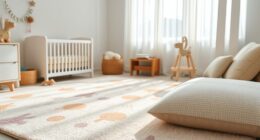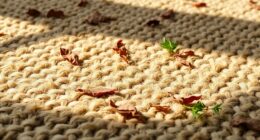To select rugs for radiant-heated floors, choose natural, breathable materials like wool or cotton that allow heat to pass easily. Opt for low-pile, tightly woven designs that don’t trap heat or insulation, promoting better warmth transfer. Avoid thick, dense rugs that block heat flow and consider size and placement to maximize efficiency and comfort. If you want helpful tips on choosing the perfect rug, keep exploring how to balance style and function.
Key Takeaways
- Choose low-pile or flatweave rugs to facilitate efficient heat transfer and prevent heat trapping.
- Opt for natural, breathable fibers like wool or cotton that allow heat to pass through easily.
- Avoid thick, dense, or plush rugs that can insulate and reduce heating efficiency.
- Use non-slip pads to secure rugs safely and prevent movement that could damage heated flooring.
- Regularly clean and maintain rugs to preserve material integrity and ensure consistent heat flow.
Understanding How Radiant Heating Works and Its Impact on Rugs

Radiant floor heating works by circulating warm water or electric currents beneath your floor, directly warming the surfaces and the objects in the room. This method creates a gentle, even heat that rises upwards, warming everything in its path. Unlike traditional heating systems, radiant heat doesn’t rely on air circulation, reducing drafts and allergens. Because the heat is delivered directly to the floor, it can warm your space efficiently and comfortably. However, this setup also impacts the type of rugs you can use—certain materials can trap heat or hinder heat transfer. Understanding how radiant heating works helps you choose the right rugs that won’t block warmth or cause damage. Properly selected rugs enhance comfort without compromising the efficiency of your heating system. Additionally, selecting appropriate rug materials can help maximize heat transfer and prevent heat retention issues.
Ideal Materials for Rugs on Heated Floors
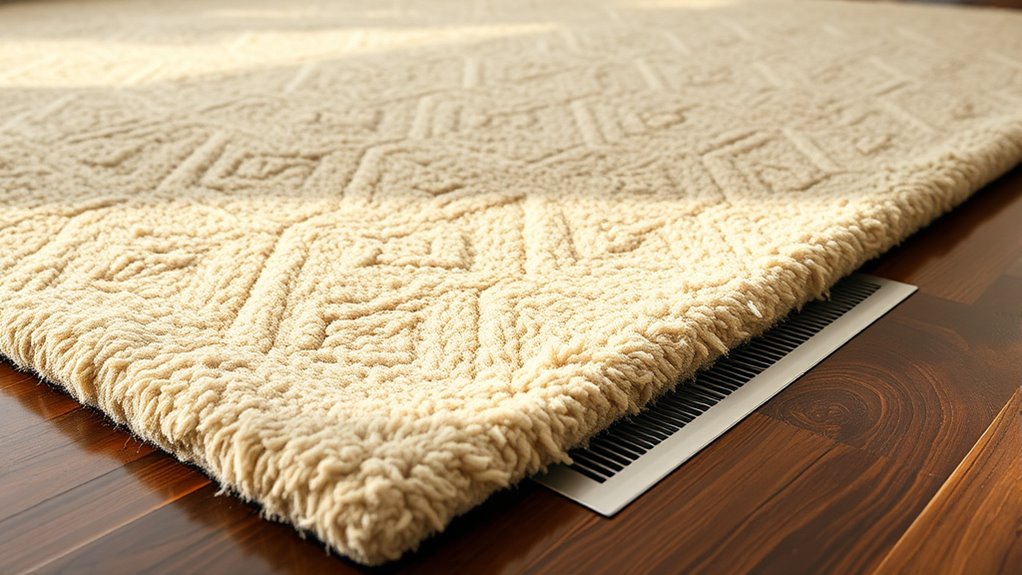
Choosing the right material for your rugs makes a significant difference in maintaining the effectiveness of your radiant floor heating. You want materials that won’t insulate the heat or block its transfer to the room. Natural fibers like wool and cotton are excellent choices because they’re breathable and allow heat to pass through easily. Synthetic fibers, such as nylon or polypropylene, tend to trap heat and reduce efficiency, so they’re less ideal. Additionally, low-pile rugs with tight weaves promote better heat transfer than thick, plush options. Selecting the right material ensures your heated floor performs at its best while also providing comfort and style. Proper material selection can also help prevent heat loss and improve energy efficiency in your space.
Thickness and Density: Finding the Balance for Efficient Heat Transfer

Finding the right balance between thickness and density is key to ensuring your rug allows heat to pass efficiently. Thicker rugs can insulate, reducing heat flow and making your floor less warm. Conversely, thinner rugs typically transfer heat better but might lack comfort or style. Density also matters; a dense rug can trap air and insulate, hindering heat transfer, while a less dense rug allows heat to flow more freely. You want a rug that’s thin enough for heat to pass easily but dense enough to provide comfort and durability. Look for low-pile or flat-woven options that strike this balance. Additionally, selecting a rug made from heat-conductive materials can further enhance the efficiency of your radiant-heated floors. By choosing a rug that’s appropriately thin and not overly dense, you optimize heat transfer without sacrificing aesthetics or comfort.
Durability and Maintenance Considerations
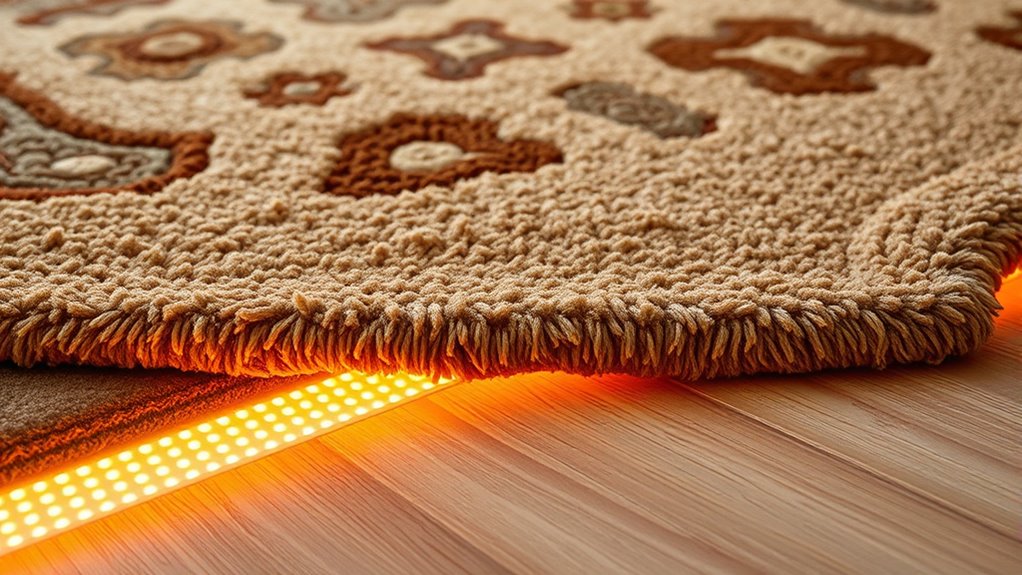
When choosing a rug for your radiant-heated floors, durability and how easy it is to maintain should be top priorities. You need materials that last and resist heat damage, so your rug stays looking good over time. Consider how simple it is to clean and care for the rug to keep your space comfortable and hassle-free.
Material Durability and Longevity
Since radiant-heated floors can impact the durability of rugs, selecting materials that withstand consistent warmth is essential. You want a rug that maintains its integrity over time without warping or fading. Look for fibers specifically designed for heat exposure, such as wool or synthetic blends known for resilience. These materials resist heat damage and keep their appearance longer. Additionally, consider the rug’s construction—tightly woven or low-pile options tend to last longer under constant warmth. Proper backing also helps prevent slipping and reduces wear. To maximize longevity, avoid delicate fibers and overly plush textures that trap heat and moisture, risking deterioration. Being aware of heat-resistant fibers can help you choose the most durable options for radiant-heated floors.
Cleaning and Upkeep Ease
Choosing a rug that can withstand regular cleaning and maintenance is key to preserving its appearance and function over time, especially on radiant-heated floors. Look for materials that are easy to vacuum and clean without special treatments. Low-pile or tightly woven rugs tend to trap less dirt and are simpler to maintain. Avoid rugs with delicate fibers or high pile that can trap dust and require professional cleaning. Consider removable rugs or mats that can be shaken out or washed easily. Regularly cleaning your rug not only keeps it looking fresh but also prevents dirt buildup that could affect heat transfer. Selecting durable, low-maintenance rugs helps you enjoy comfort without the hassle of frequent upkeep, ensuring your floor stays both beautiful and functional. Additionally, choosing durable rug materials that resist wear and tear can extend the lifespan of your rug on heated floors.
Resistance to Heat Damage
To make certain your rug withstands the heat from radiant floors, it’s essential to select materials that resist heat damage and maintain their integrity over time. Look for rugs made from heat-resistant fibers that won’t warp or discolor under consistent warmth. Synthetic materials like nylon or polyester generally perform well, but some natural fibers can be treated for better heat resistance. Avoid rugs with latex backing, as it can soften or degrade with heat. Regularly check for signs of wear or damage to prolong your rug’s lifespan. Additionally, selecting appropriate fibers that are specifically designed for high-temperature environments can significantly enhance durability and performance.
Design and Style Tips for Complementing Your Heated Floors
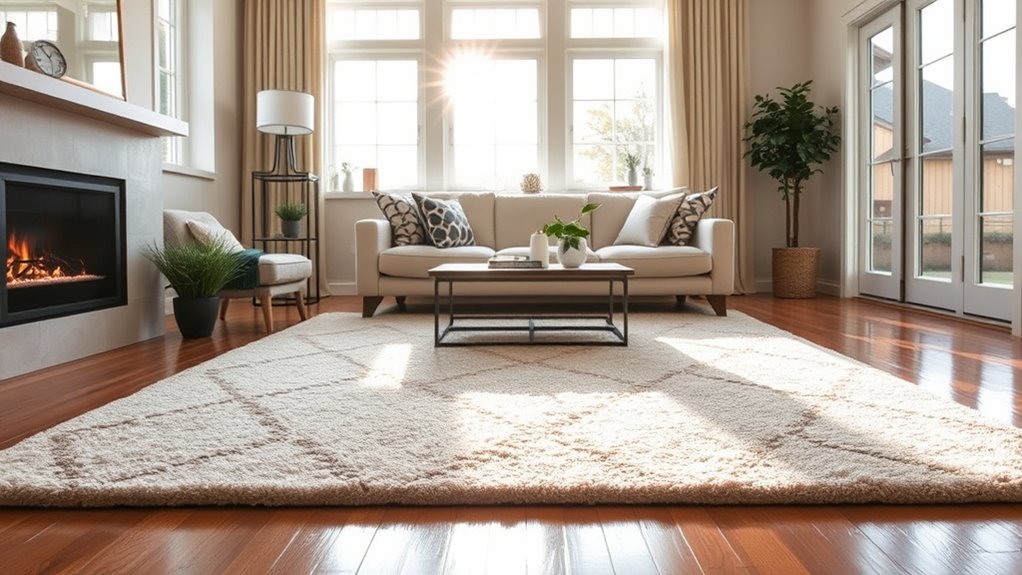
When selecting rugs for your radiant-heated floors, it’s essential to take into account how the style and materials complement the warmth and efficiency of the heating system. Opt for rugs with low pile or flatweave designs, as they allow heat to pass through easily, maintaining comfort and energy efficiency. Choose colors and patterns that enhance your room’s overall decor, ensuring they don’t clash with your flooring or furniture. Natural materials like wool, cotton, or bamboo work well because they’re durable and don’t trap heat. Keep the rug size proportional to the space—larger rugs create a cozy feel without obstructing heat flow. Additionally, selecting rugs that align with Boho Decor elements can add a unique personality to your space. Ultimately, select styles that balance aesthetic appeal with practicality, ensuring your heated floors stay functional and stylish.
Installation and Placement Tips for Optimal Performance
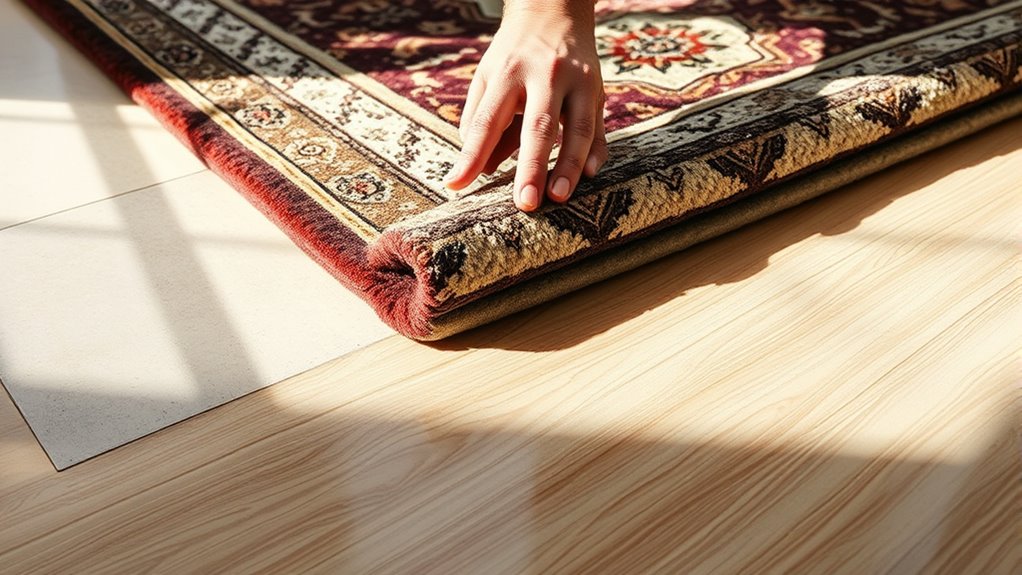
Proper installation and placement of rugs can substantially influence the efficiency and comfort of your radiant-heated floors. To maximize performance, guarantee rugs are lightweight and breathable, allowing heat to pass through effectively. Avoid thick, dense rugs that trap heat and reduce efficiency. Use rug pads made of non-slip, heat-permeable materials to keep the rug in place without hindering heat transfer. Position rugs away from vents and heat sources to prevent uneven heating and potential damage. Regularly lift and check under the rug to prevent moisture buildup. Proper placement not only boosts heating efficiency but also prolongs the life of your flooring. Incorporating knowledge from Honda Tuning can help you understand how to optimize your setup for better performance and durability.
Frequently Asked Questions
Can Area Rugs Improve or Hinder Heating Efficiency?
Area rugs can both improve and hinder heating efficiency, depending on their material and placement. Thick or plush rugs insulate the floor, trapping heat and making the room warmer, but they can also block heat transfer to the space below. To maximize efficiency, choose thin, breathable rugs and place them carefully so they don’t obstruct heat flow. Proper selection and placement help you enjoy comfort without sacrificing your radiant heating system’s performance.
Are There Specific Colors That Work Best With Radiant Heating?
Like a painter choosing hues for a masterpiece, you wonder if certain colors enhance your radiant floor’s warmth. Bright, light shades reflect heat, acting like mirrors that bounce it around your space, while darker tones absorb and retain it, creating a cozy cocoon. You should opt for lighter colors to maximize heat efficiency, ensuring your room stays warm and inviting without compromising style.
How Do Rug Pads Affect Heat Transfer and Safety?
Rug pads play a vital role in heat transfer and safety. They insulate the floor, which can reduce the warmth from radiant heating, but quality pads designed for heated floors allow heat to pass through efficiently. Safety-wise, pads prevent slipping and protect your flooring, reducing the risk of damage. Choose thin, non-porous, and heat-conductive pads to maximize comfort, safety, and heat efficiency in your space.
What Are the Best Cleaning Methods for Rugs on Heated Floors?
Think of your rug as a cherished garden that needs gentle care. To keep it vibrant on heated floors, vacuum regularly with a brushless suction to prevent damage. Spot clean stains immediately with mild solutions, avoiding excessive moisture. Occasionally, have your rug professionally cleaned to preserve its fibers. This gentle maintenance guarantees your rug thrives without blocking heat, creating a cozy, safe haven for your home.
Can Pets Damage Rugs Installed on Radiant-Heated Surfaces?
Pets can indeed damage rugs on radiant-heated floors. They might scratch or chew the fibers, especially if they’re playful or anxious. Your pets could also cause indentations or wear spots over time. To protect your rugs, train your pets to avoid rough behavior, trim their nails regularly, and choose durable, pet-friendly rugs. Proper maintenance and supervision help keep your rugs looking good and prevent damage on heated surfaces.
Conclusion
Remember, a well-chosen rug can warm up your space both literally and visually. By selecting the right materials, thickness, and style, you’ll enjoy cozy comfort without sacrificing efficiency. Keep in mind, “A stitch in time saves nine”—taking the effort to select the perfect rug now prevents future discomfort or damage. With thoughtful choices, your heated floors will stay beautiful, functional, and inviting for years to come.






